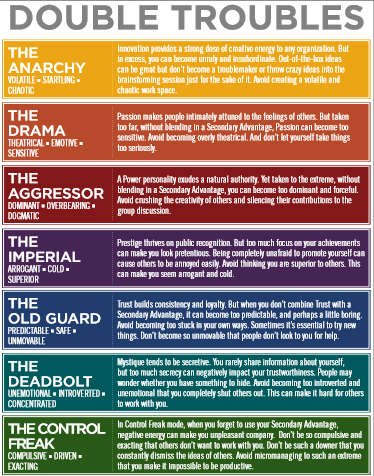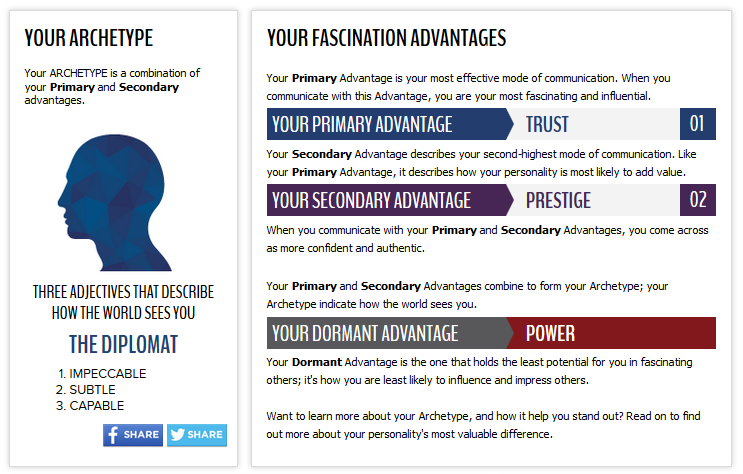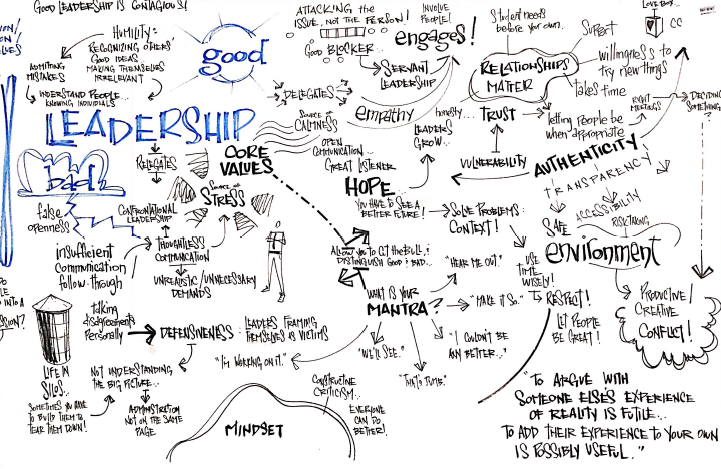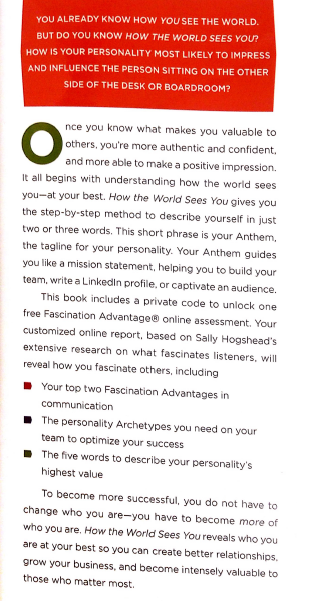In Part 3 of How the World Sees You, Sally Hogshead takes you through the process of creating your own Anthem.
“Successful brands distinguish themselves from the competition, often with only a mere sliver of a competitive difference. Similarly, we will distill your personality’s key defining qualities into just a few words, summarizing your key benefits.”
I created my anthem by utilizing the following steps:
- Pick one adjective (how you are different)
- Pick one noun (what you do best)
- Bring the words together to create your anthem.
After creating my Anthem, I put it through these tests.
- “If you need someone who delivers (fill in your Anthem), I can help.”
- “Even when things get tough, I promise to give (fill in your Anthem).”
- “If you’re like me, you want someone to can give (fill in your Anthem).”
My Anthem: Levelheaded tenacity
I chose the words for my Anthem very carefully. I took the key traits from my Primary and Secondary Advantages (Trust and Prestige) in order to compose my Anthem.
My Anthem encompasses who I am and how I add value!
As I finish reading the book How the World Sees You, I look back at my goals and think about why our Head of Schools specifically chose this book for me. At the conclusion of this book, I feel that I have a different perspective about how I communicate and how I add distinct value. I have struggled with confidence throughout my journey as an educator and I feel that this book has helped me to look at who I am, what sets me apart from others and, how I want people to see me. I have a better understanding of how others perceive me based on the patterns of signals and cues that I use to communicate. After learning more about my Advantages and how I am most fascinating to others, I need to put myself in situations that allow me to utilize my Advantages in order to contribute to the success of our team. Before reading this book, I felt I had good understanding of who I am and how I contribute to a team, but I feel that I can be more confident in who I am and communicate in ways that will fascinate. I am on the path to becoming more of who I am!
“Struggling to improve your areas of averageness can only take you so far–and it can cost you years of wasted effort and opportunity…Instead of trying to “fix” the parts of yourself that are a commodity, you can achieve more by just feeding that tiny but extraordinary streak. Don’t change who you are, become more of who you are.”
In Appendix D of How the World Sees You, twelve inspirations from the book are included. These inspirations are the perfect end to the book! Reflect on these inspirations and share them with others, I know I plan on doing just that!
Inspirations:
12. The greatest value you can add is to become more of yourself.
On some level, we all have a fear of being fascinating. When you rise above the fear, you rise above the fray.
11. You won’t make a difference being quiet or loud. You make a difference by being heard.
No matter what your natural communication style, you must learn how it’s being perceived by others. In order to communicate, you must learn how you communicate.
10. To be more successful, don’t change who you are. Become more of it.
When you live according to your own highest value, you become your most fascinating—and most valuable.
9. Stand out, or don’t bother.
Understand how the world sees you, and you will discover your most valuable differences. Leverage these differences to avoid commoditization.
8. Clients don’t hire you because you’re balanced. They hire you because you’re extraordinary in some way.
You can either be balanced vanilla, or extraordinary pistachio.
7. You’ll never rise to the top by being all things to all people.
If you can’t improve someone’s perception of you, or at the very least maintain it, then reconsider whether you should be engaging them in the first place. Stop exhausting yourself trying to be all things to all people.
6. 100% yourself is greater than 100% perfect.
The more you can amplify your natural Advantages, the more likely you are to be heard and remembered.
5. You don’t learn to be fascinating. You unlearn boring.
Being yourself is not a struggle. In fact, it makes you more relaxed and at ease.
4. You don’t have to find the light. You are the light.
On the day you were born, you already knew how to fascinate. Fascination is an instinctive form of connection.
3. Your personality is the greatest differentiator you have.
People can copy your product, your pricing, your actions, your recipe or program or formula. But they can never replicate who you are.
2. The way to empower someone is to show them their value.
Once someone understands how they naturally add value, they blossom. They become more confident, more persuasive, and more influential.
1. The world is not changed by people who sort of care.
Sort of caring will get you run over by someone who actually does care. Sort of caring is the on-ramp to obsolescence– a road that starts comfortably enough, but soon leads to the lonesomeness of obscurity. The world is changed by people who passionately, relentlessly care– sometimes, unreasonably so.













